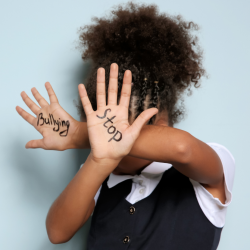A few weeks ago, we saw a video of a mother who made her daughter apologise to a girl she had bullied with a big gift hamper.
The woman, Dominique Mackey, found out that her daughter was bullying another kid and immediately took them to a mall to start purchasing her “apology”. She made a video of her daughter carrying the apology gifts into her classroom to hand them over to the girl she bullied.
In the video she posted on TikTok, captioned: “POV: Your child decided to be a follower and bully another kid today knowing you hate bullies! This is how we apologise in our household”, Dominique placed a letter of apology from her daughter alongside a range of gifts including a Krispy Kreme voucher in a gift basket. She also called the girl’s mother to offer her bullied daughter her own daughter’s hairdresser appointment that she had already paid for. The video also shows Dominique explaining what the other gifts are for on the call.
This whole ordeal got mixed comments from people online. A large group commended the way she handled the situation, another group called it an overreaction while a different group tagged it a forced apology, therefore, fake. What do you think? Let us know in the comments.
About a week ago, Lead British International School was shut down for three days following the circulation of videos online showing a female student from the school being harassed by fellow students in a very violent way.
One of the videos captures another female slapping the victim several times while asking, “Who broke my heart?” The video is absolutely painful to watch and shows how brutal children can be to other children.
Seeing your child being mean to others, or worse, being the target of such cruelty, is even more heart-wrenching. But as hard as it is to wrap your head around it, it’s crucial to face it head-on.
Understanding Bullying
Bullying, whether it’s physical or verbal, isn’t just some childhood rite of passage that kids have to endure. If left unchecked, it can snowball into something far worse. We’re talking about more aggression, more antisocial behaviour, and potentially even long-term consequences that mess with a child’s success in school and their ability to make and keep friends.
Think about it: when a child is constantly picked on or made to feel worthless, it chips away at their self-esteem. They start to believe the hurtful things that are said to them. They might even start acting out or becoming withdrawn because they don’t feel safe or valued in their environment. And that’s not something any parent wants for their child.
Addressing bullying isn’t just about punishing the bullies. It’s about teaching empathy, respect, and kindness. It’s about creating a culture where every child feels seen, heard, and supported. It’s about giving kids the tools they need to navigate conflict healthily.
So yes, it’s uncomfortable to talk about. It’s uncomfortable to acknowledge that your child might be capable of hurting others. But sweeping it under the rug isn’t going to make it go away. We owe it to our kids – both the bullied and the bullies – to have those difficult conversations, to listen to their concerns, and to work together to build a community where everyone feels safe and valued.
Reasons Why Kids Bully Others
There are many reasons why kids bully. Some do because they feel insecure. Picking on someone who seems emotionally or physically weaker provides a feeling of false satisfaction and an ego boost. In other cases, kids bully because they simply don’t understand that it’s wrong to pick on kids who are different because of size, looks, race, or religion.
Child abuse can profoundly influence a child’s development, potentially fostering bullying tendencies. Children often replicate the abusive behaviour they experience or witness, using bullying as a coping mechanism to regain control or deal with their trauma. In environments where abuse is normalized, violence may be seen as an acceptable solution to problems. Additionally, abuse can hinder the development of healthy social skills and emotional regulation, leading to impulsive and aggressive behaviour. Children may bully others to elevate their own status and seek attention or validation from peers or authority figures. Preventing child abuse and providing support for affected children are critical steps in breaking this cycle, with early intervention, counselling, and creating safe environments playing key roles in promoting healthier outcomes.
Some kids who bully at school and in settings with their peers are copying behavior that they see at home. Kids who are exposed to aggressive and unkind situations in the family often treat others the same way. And kids who are on the receiving end of taunting learn that bullying can translate into control over others whom they perceive as weak.
How to Teach Kids not to be Bullies
Helping kids stop bullying requires a proactive and multi-faceted approach that begins with clear communication and understanding. Start by letting your child know unequivocally that bullying is unacceptable and will result in serious consequences if they refuse to change their behaviour for the better.
To effectively address bullying, it’s essential to understand the underlying reasons behind it. Some of which we’ve mentioned earlier.
Now, here are some ways to avoid raising a bully:
1. Take bullying seriously: Establish clear rules about bullying and enforce them consistently. If your child engages in bullying behaviour, ensure the consequences are meaningful and proportional to the offense. For example, if bullying occurs online, consider restricting access to electronic devices. Additionally, address any aggressive behaviour at home promptly and teach alternative ways to react, such as walking away from conflict.
2. Teach respect and kindness: Instil in your child the values of treating others with respect and empathy. Challenge stereotypes and encourage your child to embrace diversity by participating in community activities where they can interact with children from different backgrounds.
3. Stay involved in your child’s social life: Maintain open communication with your child and stay informed about their peer interactions. Talk to other parents, teachers, and school staff to gain insights into the social dynamics at school and any pressures your child may face. Encourage involvement in extracurricular activities to broaden their social circle and build positive relationships.
4. Encourage positive behaviour: Acknowledge and reward your child’s constructive and positive actions. Positive reinforcement can be more effective than punitive measures in shaping behaviour.
5. Set a good example: Model respectful communication and conflict resolution skills in your own interactions. Be mindful of how you speak to your children and handle strong emotions, as they often mimic parental behaviour.
When examining the influences on your child’s behaviour, consider the home environment first. Children who witness or experience aggression or criticism at home may replicate such behaviour elsewhere. Monitor sibling interactions and intervene when necessary to address name-calling or physical confrontations.
If your family is undergoing a stressful life event, seek support from counsellors, therapists, or other professionals who can provide guidance and assistance.
Remember, addressing bullying requires collaboration between parents, educators, and other stakeholders. Engage with school officials and consider seeking professional help if necessary. While challenging, intervening early to stop bullying is essential for promoting a safe and supportive environment for all children.




